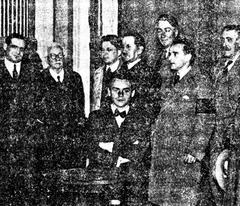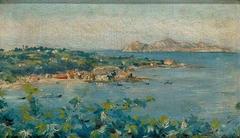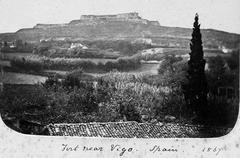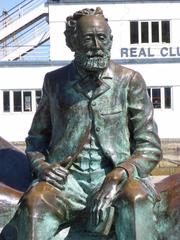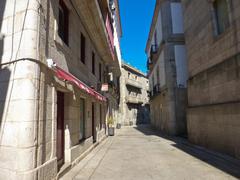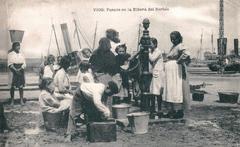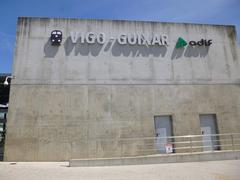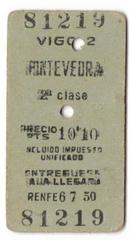
Monte da Guía Visiting Hours, Tickets, and Complete Travel Guide to Vigo’s Historic Site
Date: 04/07/2025
Introduction
Monte da Guía stands as one of Vigo’s most iconic landmarks, blending breathtaking natural scenery, centuries-old maritime heritage, and vibrant Galician cultural traditions. Perched atop a scenic promontory overlooking the Ría de Vigo estuary, this historic hill offers visitors panoramic views, a rich tapestry of local history, and a welcoming space for both quiet reflection and lively community gatherings. Whether you are a history enthusiast, a nature lover, or a traveler eager to explore Vigo’s unique identity, Monte da Guía is a must-visit destination.
This comprehensive guide provides everything you need to know before visiting Monte da Guía: detailed historical background, cultural significance, visiting hours, ticket policies, transportation options, accessibility, highlights of annual festivals, and practical travel tips. For up-to-date information and deeper insights, trusted resources include Turismo de Vigo, Spain.info, Great Runs, and Try Travel.
Historical Background and Strategic Importance
Monte da Guía rises approximately 65 meters above sea level on Vigo’s northeastern edge. Its elevated position made it a critical lookout and defense point from the 16th century onward, as Vigo’s port grew in significance amid frequent maritime conflicts. The hill’s vantage allowed for early detection of ships, both friendly and hostile, making it essential to the protection and development of the port city.
During the War of Spanish Succession and the Battle of Vigo Bay in 1702, Monte da Guía played a role in monitoring naval movements. Remnants of defensive structures and signaling posts still found on the hill offer tangible links to its military past. Over time, the site evolved from a strategic bastion to a center of community, faith, and cultural expression.
The Hermitage of Nosa Señora da Guía
At the summit stands the Hermitage of Nosa Señora da Guía, originally built by local fishermen in the late 16th century. The present chapel, restored in the 20th century, combines simple Galician stonework with maritime motifs, symbolizing the city’s close relationship with the sea. The hermitage quickly became a focal point for both religious devotion and social gatherings, with annual pilgrimages remaining a beloved tradition.
Maritime Heritage and Local Traditions
Monte da Guía’s identity is inextricably linked with Vigo’s seafaring past. For generations, fishermen, shipbuilders, and their families gathered here to seek blessings, give thanks, and honor those lost at sea. Local folklore is rich with tales of miraculous rescues attributed to the Virgin of the Guide, reinforcing the hill’s status as a place of hope and remembrance.
Its proximity to historic fishing neighborhoods like O Berbés and Teis further cements its importance in maritime culture. Annual festivities, such as the Romería da Virxe da Guía, bring the community together to celebrate their enduring connection to the Atlantic.
Modern Restoration and Preservation
Recent decades have seen significant restoration efforts at Monte da Guía. The hermitage was carefully renovated to preserve its original character, and the surrounding parklands were enhanced for visitor access and interpretation. Monte da Guía is now a protected cultural site, integrated into local educational programs and regional tourism initiatives.
Scenic Views and Natural Setting
Monte da Guía is renowned for its panoramic vistas. From the summit, visitors enjoy sweeping views across the Ría de Vigo, the bustling port, the iconic Rande Bridge, and the distant Cíes Islands. Interpretive panels help contextualize these sights, tracing Vigo’s evolution from a fishing village to a modern maritime city.
The hill itself is a lush green space, home to native Galician flora such as pine, eucalyptus, and wild shrubs. Birdwatchers will find seabirds and migratory species, while the nearby rocky shores offer glimpses of marine life during low tide. The tranquil atmosphere, enhanced by ocean breezes and a peaceful setting, makes Monte da Guía an ideal retreat from urban bustle.
Visitor Information
Visiting Hours:
- Open daily from 8:00 AM to 8:00 PM (extended hours in summer).
- The hermitage is generally accessible during these times or by appointment, with special access during religious events.
Tickets and Entrance Fees:
- Entry to Monte da Guía and the hermitage is free of charge.
Guided Tours:
- Guided tours are available through local tourism offices and are often included in broader Vigo historical site tours. Advance booking is recommended.
Accessibility:
- The ascent includes some steep and uneven sections. While there are paved paths and resting benches, visitors with limited mobility may find parts of the site challenging. Parking is available near the summit for car or taxi access.
Transportation:
- Bus: Line 17 and C3D connect central Vigo to Monte da Guía.
- Train: Vigo - Urzáiz station is a 9-minute walk away.
- Ferry: Vigo - Estación Marítima is 12 minutes on foot.
- Funicular: Ascensor Halo station, 17 minutes away.
- For real-time schedules, use the Moovit app.
Facilities and Travel Tips
- Facilities: Benches, shaded picnic areas, and interpretive signage are available. Restroom facilities are limited.
- Safety: Wear sturdy shoes, bring water, and use sun protection. The summit can be breezy; a light jacket is recommended.
- Events: Check local listings for festival dates, especially the Romería da Virxe da Guía in early August and other community celebrations.
- Pets: Pets are allowed on a leash.
Annual Festivals and Community Events
Romería da Virxe da Guía
This traditional pilgrimage and festival, held in early August, is the highlight of the calendar. Locals and visitors ascend the hill for open-air masses, processions, music, and communal feasts. The celebration blends spiritual devotion with Galician hospitality (Turismo de Vigo).
Virgin of Carmen Festival
Celebrated in July, this festival honors the patron saint of sailors. While centered in the port, Monte da Guía often serves as a secondary site for processions and music, reflecting its maritime legacy (Vigo.com Festivals).
Bouzas Festivities and Fireworks
Monte da Guía is a favored spot to watch the spectacular fireworks over the estuary during Bouzas’ summer festival, transforming the hill into a lively amphitheater (Vigo.com Festivals).
Semana Grande and Christ of the Victory
Vigo’s biggest festival in August includes processions, music, and citywide celebrations. The hill’s views make it a peaceful retreat during these festivities (Vigo.com Festivals).
Celtic and Traditional Galician Festivals
Monte da Guía’s tranquil setting hosts smaller gatherings and nature walks as part of citywide celebrations of Galicia’s Celtic and folk heritage (Discovering Vigo).
Activities at Monte da Guía
- Hiking & Walking: Well-maintained trails ascend gently to the summit, with benches and viewpoints along the way (Great Runs).
- Picnics: Designated areas make it ideal for outdoor meals with sweeping views.
- Photography & Birdwatching: The unique combination of historic architecture, natural beauty, and panoramic seascapes provides outstanding photo opportunities.
- Outdoor Recreation & Wellness: The tranquil environment is perfect for yoga, meditation, and relaxation (Danas Vistas).
- Educational Visits: Occasionally, guided walks, workshops, and school programs are organized on the hill (Hoxe Vigo).
Nearby Attractions
- Beaches: Praia da Lagoa and Praia da Punta are accessible on Monte da Guía’s slopes, offering swimming and relaxation.
- Cíes Islands: Visible from the summit and accessible by ferry from Vigo’s port (Try Travel).
- Vigo Old Town (Casco Vello): A short bus or taxi ride away, famous for its historic charm and lively taverns.
- Museo do Mar de Galicia: Maritime museum celebrating the region’s sea-faring past.
- Rande Bridge & Ensenada de San Simón: Enjoy dramatic vistas and learn about the region’s engineering and folklore.
- Other Parks: Parque de Castrelos and Monte O Castro offer additional green spaces and historical monuments.
- Unique Stays: Glamping options nearby include Kampaoh Ría de Vigo and Amaraxe Ecoglamping.
Visuals and Interactive Elements
Explore high-quality images and virtual tours at GaliciaAberta. Suggested alt tags for accessibility and SEO include “Monte da Guía panoramic view,” “Hermitage of Nosa Señora da Guía,” and “Vigo estuary from Monte da Guía.”
Frequently Asked Questions (FAQ)
Q: What are Monte da Guía’s visiting hours?
A: The site is open daily from 8:00 AM to 8:00 PM (extended in summer). The hermitage is open during special events or by arrangement.
Q: Is there an entrance fee or do I need tickets?
A: No, entry to Monte da Guía and its trails is free. Hermitage access during special events may require tickets.
Q: Are guided tours available?
A: Yes, guided walks can be arranged through local tourism offices, especially during festivals or by request.
Q: Is Monte da Guía accessible for people with disabilities?
A: The main trails are gentle, but some steep and rocky areas may be challenging. Parking near the summit is available.
Q: How do I get there by public transport?
A: Bus lines 17 and C3D serve the area; Vigo - Urzáiz train station and Vigo - Estación Marítima ferry terminal are within walking distance. Check the Moovit app for real-time schedules.
Q: Are pets allowed?
A: Yes, pets are welcome but should be kept on a leash.
Summary & Travel Tips
Monte da Guía offers a unique blend of panoramic natural beauty, deep-rooted maritime history, and vibrant Galician tradition. Its accessible location, free entry, and well-maintained trails make it suitable for visitors of all ages and interests. Whether attending a festival, enjoying a picnic with views, or exploring nearby attractions, Monte da Guía is the perfect gateway to the soul of Vigo.
For the latest updates, guided tour options, and event listings, consider downloading the Audiala app and following local tourism channels. To plan your visit, consult GaliciaAberta and the Moovit app for transportation guidance.
References
- Great Runs: Monte da Guía Vigo
- Turismo de Vigo: Monte da Guía
- Try Travel: Things to Do in Vigo
- GaliciaAberta: Virtual Tour of Monte da Guía
- Vigo Festivals and Cultural Events
- Spain.info: Vigo Destination Guide
- Moovit Public Transit App for Monte da Guía
- Glamping Guide for Vigo


